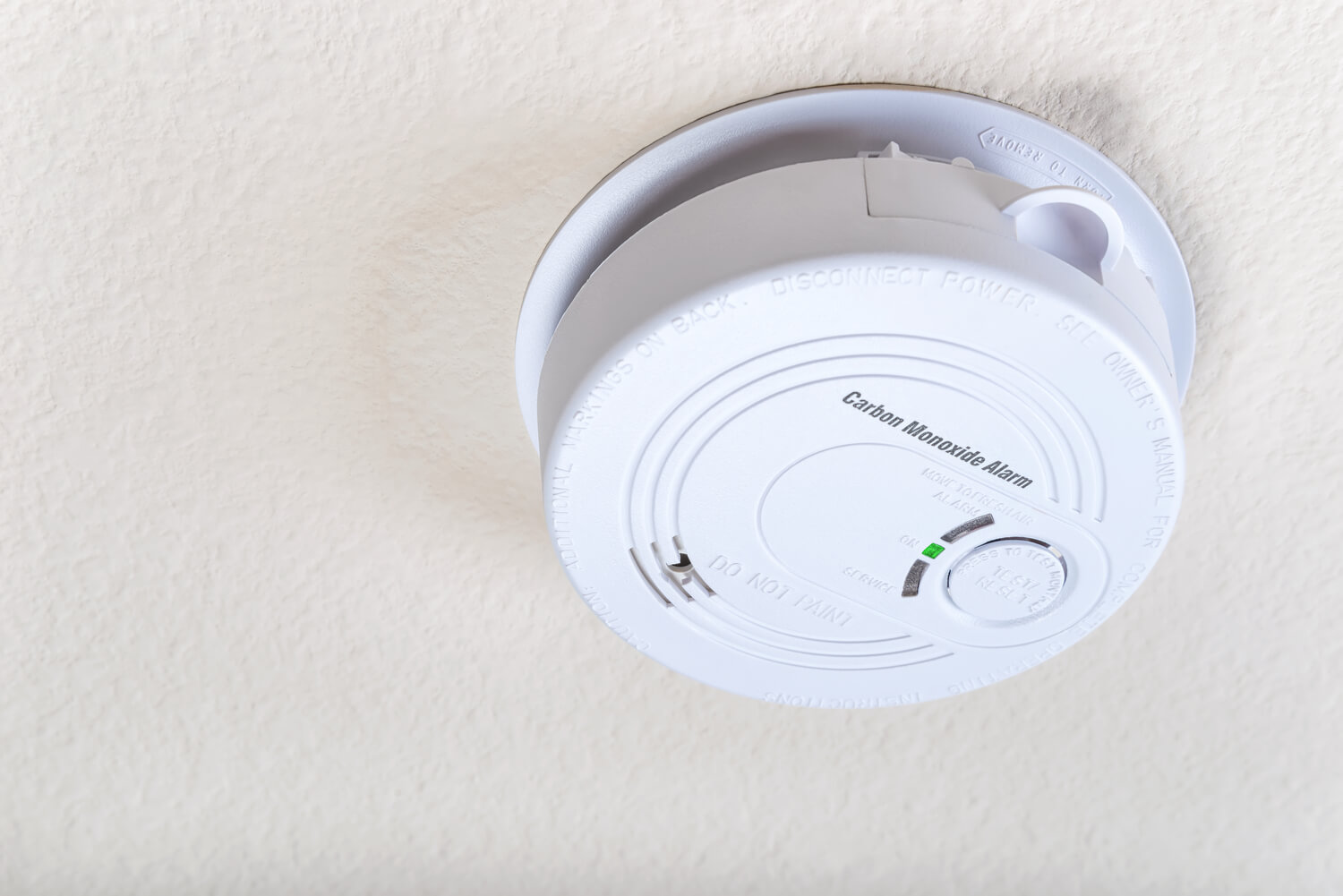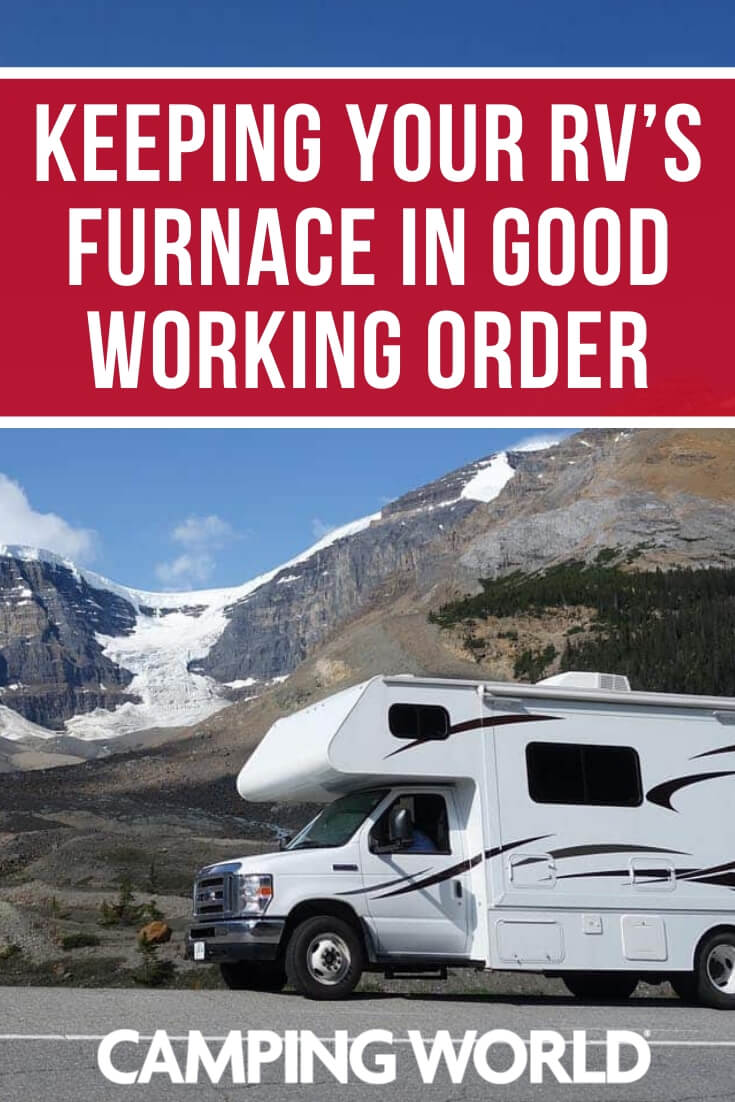If you’re out camping in the fall, winter, or early spring, keeping your RV furnace in good working order is essential. Like anything else, the furnace in your RV requires maintenance to operate efficiently and reliably. You’ll want a working furnace to keep you warm when outside temperatures drop unpredictably.
The truth is, certain furnace maintenance tasks are best left to the pros. That being said, it’s up to you to know when to call for help. Plus, there are some simple maintenance tasks you can do yourself.
So let’s talk about everything you need to know to keep your RV’s furnace in tip-top shape.
How to Check That Your RV Furnace Works
Conducting a furnace test is a great place to start and you can perform this task on your own. It’s really as simple as turning your furnace on and making sure it is running properly. Here’s how to do it:
How to Do A Quick RV Furnace Test

Locate your RV’s thermostat and adjust the temperature setting so it’s higher than the current air temperature in your rig. Within 15-30 seconds, you should hear the pilot light ignite. Wait and listen for the fan to kick on and you should soon feel hot air coming from the vents throughout your RV.
Let your furnace run for several minutes while you listen to it. Are there any high-pitched or disconcerting sounds? If so, make a note of them. Also, pay attention to any pungent, gaseous smells, as these could be a sign that something is off.
If you smell propane, it could simply be a sign that your propane tank is running low. So start by checking your tank capacity. If your tanks aren’t low, shut off your furnace to stop the flow of LP gas immediately.
Open roof vents and windows to allow propane fumes to escape. Then, it’s time to call an RV professional to inspect your rig for propane leaks.
Note: A dusty smell coming from your furnace vents isn’t uncommon. It simply indicates that dust or other debris has accumulated in your vents or ductwork and is being burned off. This is typical when running your furnace for the first time of the season.
Testing Related Safety Appliances for RV Furnaces
In addition to testing the furnace itself, make sure things like your carbon monoxide detector, LP gas regulator, and propane leak detector are working properly. Some of these appliances can be easily maintained by replacing the batteries regularly. Others require more complex checks.
LP Gas Regulator

Your RV’s LP gas regulator, for example, must be checked and replaced regularly to maintain the safety of your rig’s entire propane system. When it comes to your furnace, you can check on the status of your LP gas regulator by firing it up and looking at the flame in the burner.
The flame should be completely blue. If you see any yellow in the flame, your regulator may need to be replaced. However, it’s worthwhile to consult an RV professional to inspect it before replacing the regulator yourself.
Carbon Monoxide Detector

For your carbon monoxide detector, make sure the red light on the unit is flashing every 30 seconds. When the red light goes out and is no longer flashing, it’s time to replace the batteries.
Propane Leak Detector
If your rig is equipped with a propane leak detector, you may be able to test it easily as well. Some models come with a ‘Test’ button that you simply hold down and wait for the correct response (i.e. an indicator light or sound coming from the unit).
However, this isn’t the case for all models. So you’ll need to consult the owner’s manual for your RV to determine the correct test procedure for your propane leak detector.
Check and Clean Your RV Furnace’s Exterior Vent

Another thing you can do is check the exterior vent on your RV furnace for excessive amounts of soot or other debris. To do this, you may need to remove the vent cover to get a closer look. If there’s a lot of soot at the vent, it is usually the result of an oxygen supply obstruction to the burner.
Fortunately, you can remove most obstructions on your own. If your RV has been sitting uncovered for some time, insects and critters may find your furnace vent a perfect place to build a seasonal nest.
To clean out your furnace’s exterior vent, you’ll need to start by removing the vent cover. Make sure your furnace is off before you do this and that the vent has sufficient time to cool down if your furnace has recently been running.
Then, remove the screws securing the vent cover to the body of the furnace. Grab a flashlight or headlamp and take a quick look into the vent for soot, nesting materials, or other debris.
If your vent is clogged, you can remove debris and clean the vent out yourself. Don’t spray any water into the vent, but it’s okay to use a damp cloth and do your best to wipe it out. You can also gently use an air compressor to blow out any loose particles that are further back in the vent.
How To Keep the Area Around Your Furnace Clean

Dust, clutter, and dirt are not a propane furnace’s friend. In other words, the dirtier you let your RV become, the more debris is likely to accumulate inside your RV furnace, vents, and ductwork. Commit to a regular RV cleaning schedule and include cleaning of vents and even the body of the furnace itself.
Keeping the area around your RV furnace clean and clutter-free is one of the best things you can do to maximize the lifespan of this RV appliance.
Installing a central vacuum in your RV makes it a lot easier to keep your rig clean. Also, getting an exterior patio mat will reduce the amount of dirt and debris that gets tracked inside. You may also be interested in these tips for how to keep an RV clean.
A few times a year, it’s a good idea to vacuum out any debris that has accumulated around the body of your furnace. You can gain access to some units from inside your RV (usually behind a faux drawer or cabinet door) to clean around the furnace. Others will be more easily accessible by removing an exterior panel.
In addition to vacuuming out loose debris, use a damp cloth to remove as much dust on and around the furnace as possible. Don’t use too much water or spray any cleaning solution directly on the furnace or its components at this point, as it can cause damage.
To practice good furnace care, you should also avoid crowding the furnace with a lot of clutter. Make sure the vents are never blocked with other RV appliances. Your furnace will be the most efficient and effective when you don’t have a bunch of things obstructing airflow.
Quick RV Furnace Safety Tips

If handled improperly, your furnace can be a dangerous appliance. Here are a few tips to help you operate and maintain it safely:
- Never work on your furnace while it is turned on
- Never block or modify furnace vents or vent covers in any way
- Set a reminder to regularly check the batteries in your carbon monoxide detector
- Shut your furnace off immediately if you notice a strong propane smell inside
- Always keep a working fire extinguisher accessible and stored safely in your RV
- Using a small fan near interior furnace ducts helps to circulate hot air throughout your rig
If you ever have a doubt about a furnace maintenance task you’re trying to perform on your own, please stop and call Camping World’s technical service department at 1-866-838-5304 or stop into a service center near you.
Have Your RV Furnace Professionally Inspected
If you have any major issues that you can’t solve, have your RV’s furnace inspected by a professional. In fact, it’s a healthy practice to have your RV’s furnace inspected at least once a year.
This will ensure that any issues you’ve discovered are resolved properly. It will also help to identify any other maintenance that you may have overlooked.
Checks that you may inquire about with an RV professional include DC voltage supply, pilot light operation, condition of the heater motor, LP gas regulator effectiveness, and safety appliance status (i.e. carbon monoxide and propane leak detectors).
Camping World service centers would be happy to take a look at your furnace. You can reach out to a service center near you today.












Newbie here.. so I need to run propane when running my heater?
Hi Rob,
Most RV furnaces burn propane to provide heat. You’ll simply need to have the valves on top of your propane container open to supply propane to the furnace. What make/model do you have?
i want to live full time in my motorhome in one location. But i was told that i can not run the furnace all winter as it will burn out is this true.
Hi Albert,
Your furnace is designed to cycle on and off (as it’s signaled by the thermostat) to regulate the temperature inside your RV. It shouldn’t be running continuously if operating properly. I’ve spent a full winter in a motorhome in the Sierra Nevadas and didn’t have an issue with my furnace burning out, but we also supplemented with electric space heaters rated for safe use inside an RV.
Here’s our article on space heaters if you’re interested in going that route: https://cwblog.cwmkt.app/gear-and-accessories/different-types-of-space-heaters-for-rvs/
I’d also recommend doing what you can to add insulation and improve your motorhome’s ability to retain the heat created from these two sources.
Please don’t hesitate to reach out if you have any follow up questions!